Each of the following flags has stars that represent the original 13 states
plus any new states added. The new states are as follows:
NOTE: An Act of April 4, 1818
provided for 13 stripes and one star for each state, to be added to the flag
on the 4th of July following the admission of each new state,
signed by President James Monroe.
(3) In use from May 1, 1795 to July 3, 1818, for twenty-three years,
adding Vermont and Kentucky. Total states: 15.
.png)
(4) In use from July 4, 1818 to July 3, 1819, for one year, adding
Indiana, Louisiana, Mississippi, Ohio and Tennessee. Total states: 20.
.png)
(5) In use from July 4, 1819 to July 3, 1820, for one year adding
Illinois. Total states: 21.
.png)
(6) In use from July 4, 1820 to July 3, 1822, for two years, adding
Alabama and Maine. Total states: 23.
.png)
(7) In use from July 4, 1822 to July 3, 1836, for fourteen years, adding
Missouri. Total states 24. The words “Old Glory” was first used to describe
this flag.
.png)
(8) In use from July 4, 1836 to July 3, 1837, for one year, adding
Arkansas. Total states: 25.
.png)
(9) In use from July 4, 1837 to July 3, 1845, for eight years, adding
Michigan. Total states: 26.
.png)
(10) In use from July 4, 1845 to July 3, 1846, for one year, adding
Florida. Total states: 27.
.png)
(11) In use from July 4, 1846 to July 3, 1847, for one year, adding
Texas. Total states: 28.
.png)
(12) In use from July 4, 1847 to July 3, 1848, for one year, adding Iowa.
Total states: 29.
.png)
(13) In use from July 4, 1848 to July 3, 1851, for
three years, adding Wisconsin. Total states: 30.
.png)
(14) In use from July 4, 1851 to July 3, 1858, for seven years, adding
California. Total states: 31.
.png)
(15) In use from July 4, 1858 to July 3, 1859 for one year, adding
Minnesota. Total states: 32.
.png)
(16) In use from July 4, 1859 to July 3, 1861, for two years, adding
Oregon. Total states: 33.
.png)
(17) In use from July 4, 1861 to July 3, 1863, for two
years, adding Kansas. Total states: 34.
.png)
(18) In use from July 4, 1863 to July 3, 1865, for two years, adding West
Virginia. Total states: 35.
.png)
(19) In use from July 4, 1865 to July 3, 1867, for two years, adding
Nevada. Total states: 36.
.png)
(20) In use from July 4, 1867 to July 3, 1877, for ten
years, adding Nebraska. Total states: 37
.png)
(21) In use from July 4, 1877 to July 3, 1890, for thirteen years,
adding Colorado. Total states: 38.
.png)
(22) In use from July 4, 1890 to July 3, 1891, for one year adding Idaho,
Montana, North Dakota, South Dakota and Washington. Total states: 43.
.png)
(23) In use form July 4, 1891 to July 3, 1896 for five years, adding
Wyoming. Total states: 44.
.png)
(24) In use from July 4, 1896 to July 3, 1908, for twelve years, adding
Utah. Total states: 45.
.png)
NOTE: An Executive Order of
President Taft, June 24, 1912, established proportions of the flag and
provided for arrangement of the stars in six horizontal rows of eight each, a
simple point of each start to be upward.
(25) In use from July 4, 1908 to July 3, 1912, for four years, adding
Oklahoma. Total states: 46.
.png)
(26) In use from July 4, 1912 to July 3, 1959, for forty-seven years,
adding Arizona and New Mexico. Total states: 48.
NOTE: An
Executive Order of President Eisenhower, January 3, 1959 provided for the
arrangement of the stars in seven rows of seven stars each, staggered
horizontally and vertically.
An Executive Order
of President Eisenhower, August 21, 1959, provided for the arrangement of the
stars in nine rows of stars staggered horizontally and eleven rows of starts
staggered vertically.
(27)
In use from July 4, 1959 to July 3, 1960, for one year, adding Alaska. Total
states: 49.
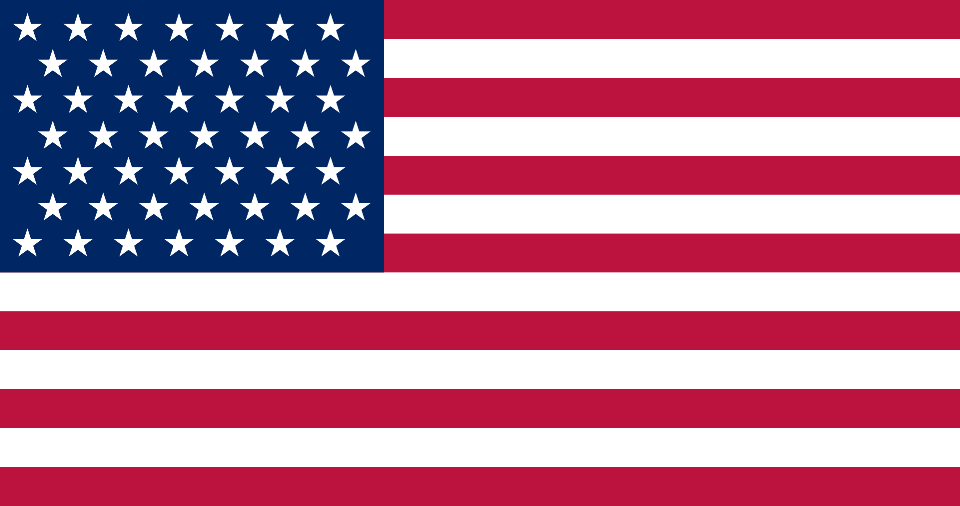
(28) In use from July 4, 1960 to the present day of this writing (2019),
for fifty-nine years, adding Hawaii. Total states: 50.
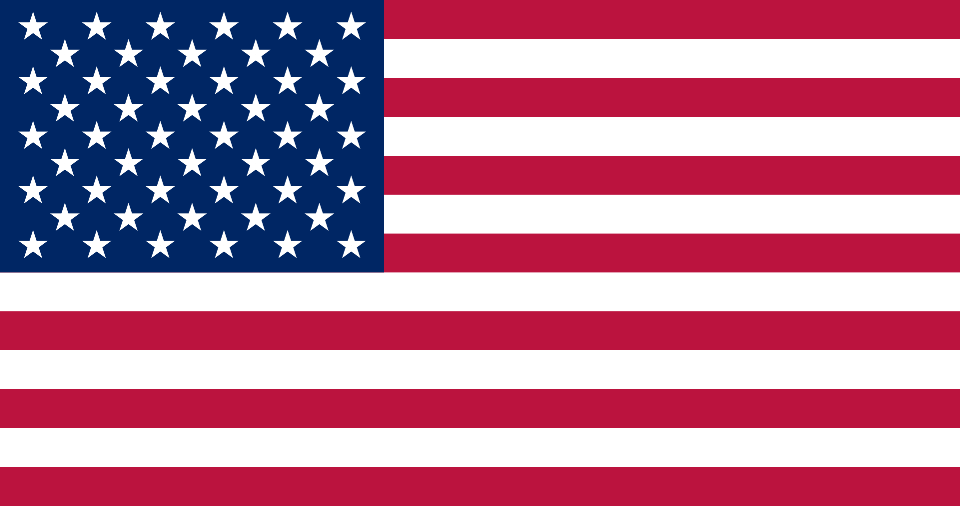
Interestingly, should there ever be the addition of a new state added to the
flag; it would require a new design to accommodate the additional star.
Such as in November 2012, Puerto Rico voted to become a U.S.
State. Nothing happened as the legitimacy of the election was disputed. Then
on June 11, 2017, another referendum was held with 97% of the voters in Puerto
Rico voting for statehood. Again this was turned down as only 23% of voters
turned out. In a similar election in November 2016, a statehood referendum was
held in the District of Columbia, whereby 86% of the voters approved
statehood. Also, it was been discussed to divide California into two or more
states.
The origin of the stars and stripes design is rumored that it is from the
Washington family coat of arms, shown in a window of Selby Abbey, which is an
Anglican parish church in the town of Selby in North Yorkshire, England. The
coat of arms of the Washington family was first used in the 12th
century when the Washington family took possession of Washington Old Hall in
County Durham, England. This same coat of arms was used by George Washington,
who was president of the United States from 1789 to 1797.
As shown here, the three red stars above the two red bands on a
white shield are on the Washington coat of arms and are a model for the
American flag. Known as the Washington Window at Selby Abbey, it can be found
in the south clerestory window of the choir and is made from 14th
century glass.

Betsy Ross
She was born
Elizabeth Griscom Ross on January 1, 1752, one of seventeen children born to
Quakers Samuel and Rebecca James Griscom in Philadelphia, Pennsylvania. She
was the eighth born of these children of which only nine survived childhood.
Known as Betsy,
she is widely known as the maker of the first American flag. According to her
family tradition, they were visited by General George Washington, who then was
the commander-in-chief of the Continental Army, in 1776. It is said that
Washington had a sketch of a flag with stars consisting of six points. Betsy
told Washington that it was easier and faster to cut material for five-point
stars, thus how the stars were made. However, there is no evidence anywhere
that substantiates this story, and it appears that it first was told by her
grandson in his writings in the 1870s, about one-hundred years later from when
she was alleged to have sewn the flag. Through research by the National Museum
of American History of the Smithsonian Institution in Washington, D.C.,
revealed that this story of Ross making the first American flag came into
being about the same time as the 1876 centennial celebration held in
Philadelphia. It seems that her grandson William J. Canby presented a paper he
had written to the Historical Society of Pennsylvania claiming that he
grandmother had “made with her hands the first flag.” Canby further claimed
that he received this information from his aunt, Clarissa Sydney (Claypoole)
Wilson in 1857, twenty-years after the death of Betsy Ross. The claim was
made based on Washington’s historic journey to Philadelphia in the spring of
1776, one year before the Second Continental Congress passed the first Flag
Day celebrated June 14, 1777.
Betsy grew up
in a house hold of very strict discipline of the Quakers. She was also in
plain dress, and learned to sew from her great aunt, Sarah Elizabeth Ann
Griscom. Upon her completion of her education at a Quaker-run state school,
her father apprenticed her to an upholsterer by the name of William Webster.
It would be here that she fell in love with another apprentice named John
Ross. John was the son of George Ross, Jr., one of the signers of the
Declaration of Independence. They eloped and married at Hugg’s Tavern in
Gloucester City, New Jersey in 1773. During their marriage they had no
children.
Her marriage
caused her to split from her Griscom family and her expulsion from the Quakers
congregation. Soon after their marriage they started their own upholstery
business, and joined the Christ Church. Its congregation included George
Washington, and his family as well as other delegates and notable people from
the Continental Congress. As this church was located in in Alexandria,
Virginia, it was not far from Washington’s home at Mount Vernon.
Because of the
belief that Betsy Ross has sewn the first flag, she had been commemorated in
many ways over the years. The United States Post Office issued a commemorative
stamp on January 1, 1952 in celebration and honor of the 200th
anniversary of her birth. This was done of course when the stories and legend
were still believed and accepted by the American public, before historical
evidence existed.
Another flag maker in Philadelphia was Rebecca Young, who is historically
credited with having made the flag of 1775-1776 that consisted of the British
Union Jack of the crosses of St. George and St. Andrew in the upper corner and
13 alternating red and white stripes that represented the 13 colonies, made
for the Continental Army and used by the navy.
Mary
Pickersgill
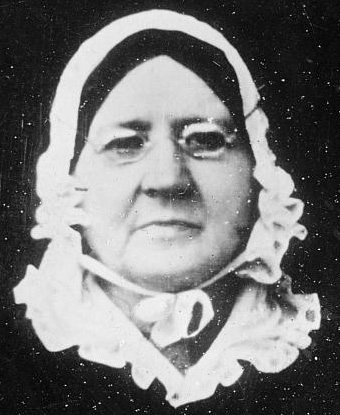
Rebecca
Young had a daughter, Mary Young Pickersgill, born on February 12, 1776 and
lived to 1857. It would be Mary who made the flag consisting of 15 stars and
stripes in 1813 that was raised over Fort McHenry. Pickersgill made this flag
at her house, but completed on the floor of a nearby brewery. It was
delivered to the commander, Major George Armistead of Fort McHenry the year
before the famous Battle of Baltimore on September 12-14, 1814, during the war
of 1812. Two flags were made. A large 30 by 42 foot one, known as the
“garrison flag,” and a smaller one, known as the “storm flag,” that was the
one seen by Francis Scott Key that was the inspiration for his poem that would
became the national anthem, “The Star-Spangled Banner.”
Following the
battle, Major Armistead took the flag, and upon his death in 1818, he went to
his widow. Louisa Hughes Armistead. She kept it for 4o years; during which
time she permitted it displayed on a few occasions, and removed pieces of it
given as gifts which were a common practice of the day. When she died in 1861,
the flag was given tom her daughter, Georgiana, then later to her grandson,
Eden Appleton. The flag was then moved to various places over a 40-year period
until 1907 when it was loaned to the Smithsonian Institution in Washington,
D.C. In December 1998, the flag began an $18 million conservation treatment,
which was not a restoration, and then became the centerpiece of the National
Museum of American History, where it remains today.
The small 1793
row-house still stands in Baltimore, and is today open for visitors known as
the “Flag House and Star- Spangled Banner Museum.”
Pickersgill was
sadly widowed at age 29, but became very successful in her flag making
business that enable her to purchase the Baltimore house, that she had been
renting previously. In addition to her flags, she became active in social
issues, assisting disadvantaged women with jobs and housing. From 1828 to 1851
she was the president of the Impartial Female Humane Society that had been
founded in 1802, and incorporated in 1811. Through Pickersgill’s help and
leadership, the organization built a home for aged women first, then another
for aged men, adjacent to the women’s. It would be these two homes that
evolved into the Pickersgill Retirement Community in Towson that opened in
1959, and named after her in 1962.
Mary
Pickersgill died on October 4, 1857 at the age of 81, and is buried in Loudon
Park Cemetery in Baltimore. Her daughter, Caroline had a monument erected in
her honor there, as a well as a bronze plaque placed at the foot of her grave
by the United Daughters of 1812 and the Star-Spangled Banner Flag
House Association. Her home, now the Flag House as mentioned herein became
such in 1927, after the house was saved through the efforts of these two
organizations who thankfully sought to preserve it.
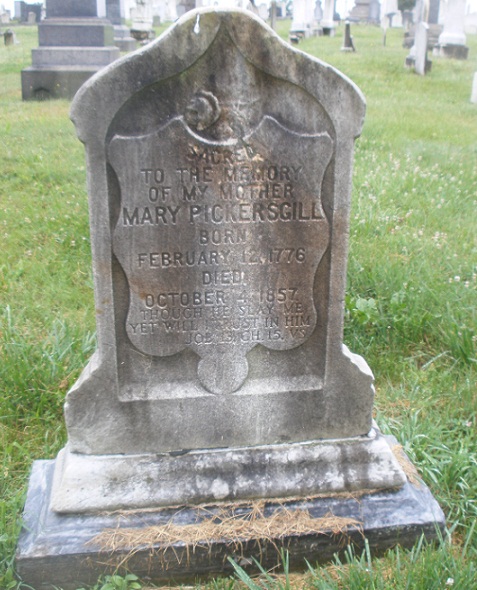
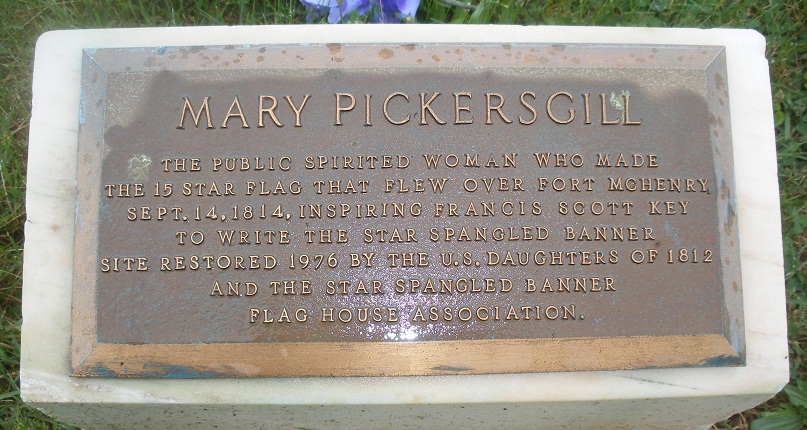
Mary
Pickersgill’s daughter, Caroline interestingly wrote a letter in 1876 to Major
George Armistead’s daughter, Georgiana Armistead Appleton, which read:
“The
large flag contained over 400 yards (370 meters) of fabric, and included 15
stripes and 15 stars, one for each of the 15 states of the union. The stars
were made of cotton and the stripes and blue canton were of English wool
bunting. Each stripe was two feet (61 cm) wide and each of the stars measured
24 inches (61 cm) across from tip to tip. The women did much of the work in
the evening after the brewery closed, sometimes working until midnight, and
Pickersgill delivered the flags to Fort McHenry on August 19, 1813, a full
year before the

